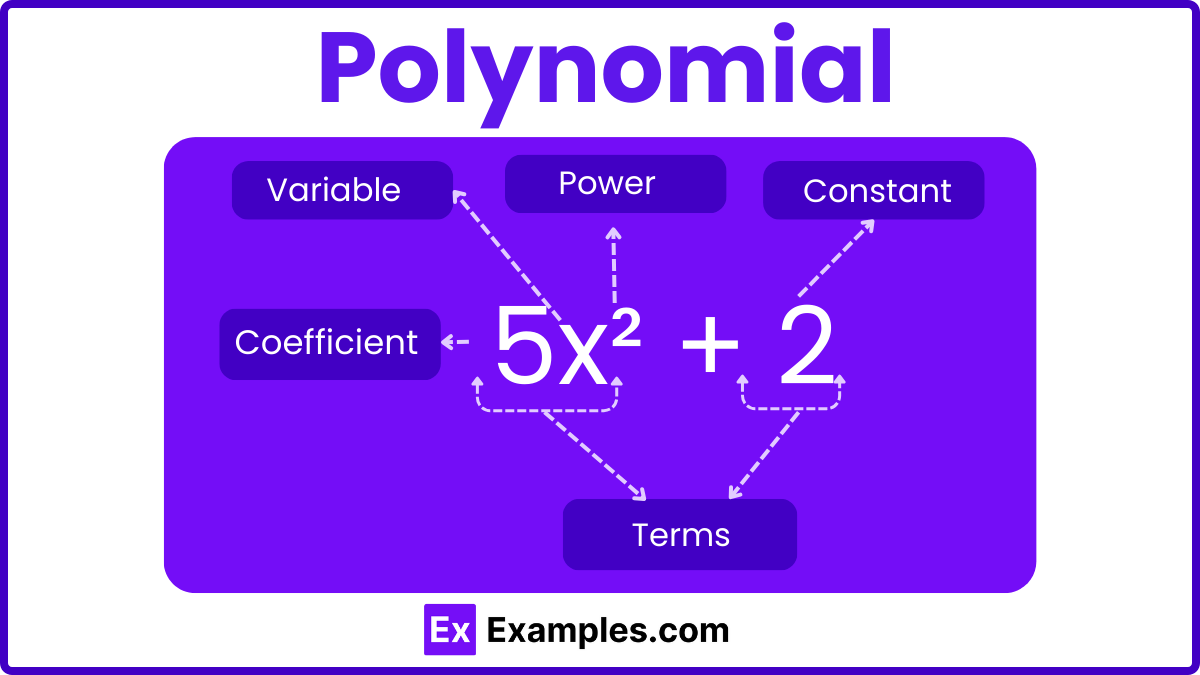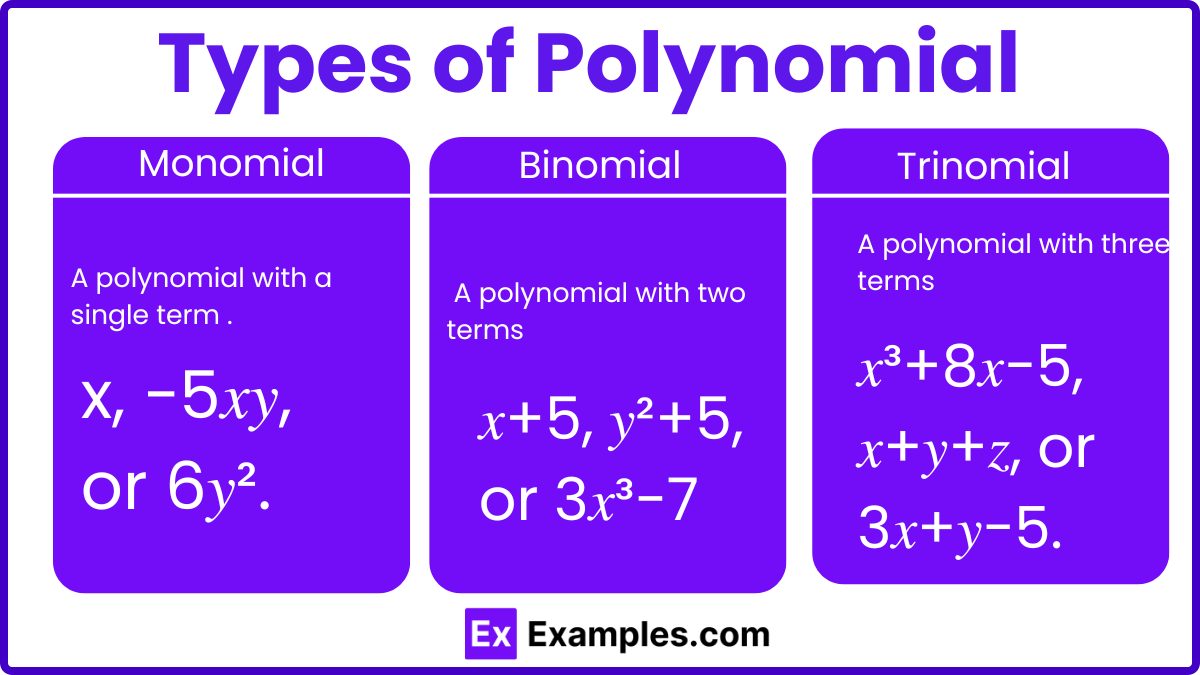Which of the following is a polynomial function?


Polynomials are mathematical expressions consisting of variables, coefficients, and non-negative integer exponents. They take the form of a sum of terms, where each term is a product of a coefficient (a constant number) and a variable raised to an exponent. For example, 3𝑥²+2𝑥−5 is a polynomial with three terms: 3𝑥² 2𝑥, and −5. Polynomials are used widely in mathematics, science, and engineering to model various phenomena and solve equations, making them essential tools for understanding and applying mathematical concepts.


Polynomials can be categorized based on the number of terms they contain and their degree:
| Monomial | Binomial | Trinomial |
| One Term | Two terms | Three terms |
| Example: x, 6y, 34, x/2 | Example: x²+x, x³-4x, y+2 | Example: x²+5x+10Polynomial Examples |
Polynomials can be classified in two ways:
P(x) = aₙxⁿ + aₙ₋₁xⁿ⁻¹ +aₙ₋₂xⁿ⁻² + ………………. + a₁x + a₀
Where aₙ, aₙ₋₁, aₙ₋₂, ……………………, a₁, a₀ are called coefficients of xⁿ, xⁿ⁻¹, xⁿ⁻², ….., x and constant term respectively and it should belong to real number (⋲ R).
The polynomial function is denoted by P(x) where x represents the variable. For example,
P(x) = x²-5x+11
If the variable is denoted by a, then the function will be P(a)
The degree of a polynomial is the highest exponent of its variables in any term. It indicates the complexity and growth rate of the polynomial function.
| Polynomial | Degree | Example |
|---|---|---|
| Zero Polynomial | Not Defined | 4 |
| Constant | 0 | P(x) = 4 |
| Linear Polynomial | 1 | P(x) = 2x+1 |
| Quadratic Polynomial | 2 | P(x) = 2x²+4x+2 |
| Cubic Polynomial | 3 | P(x) = 6x³+3x²+2x+4 |
| Quartic Polynomial | 4 | P(x) = 8x⁴+5x³+2x²+3x+1 |
A polynomial consists of one or more terms, where each term is a product of a coefficient (a constant number) and a variable raised to an exponent. Here are key points to understand about the terms of a polynomial:
A polynomial expression consists of terms connected by addition or subtraction operators. There are various properties and theorems associated with polynomials, depending on their type and the operations performed on them. Here are some key properties:
Theorem 1: If A and B are two given polynomials then,
Theorem 2: Given polynomials A and B ≠ 0, there are unique polynomials Q (quotient) and R (residue) such that,
A = BQ + R and deg R < deg B
Theorem 3 (Bezout’s Theorem): Polynomial P(x) is divisible by binomial x − a, if and only if P(a) = 0. This is also known as the factor theorem.
Theorem 4: If a polynomial P is divisible by a polynomial Q, then every zero of Q is also a zero of P.
Theorem 5: Polynomial P(x) of degree n > 0 has a unique representation of the form P(x) = k(x – x₁)(x – x₂)…(x – xₙ), where k ≠ 0 and x₁,…,xₙ are complex numbers, not necessarily distinct.
Therefore, P(x) has at most deg P = n different zeros.
Theorem 6: Polynomial of n-th degree has exactly n complex/real roots along with their multiplicities.
Theorem 7: If a polynomial P is divisible by two coprime polynomials Q and R, then it is divisible by Q⋅R.
Theorem 8: If ß is a complex zero of a real polynomial P(x), then so is ¯¯¯ß߯ (complex conjugate of ß).
Theorem 9: A real polynomial P(x) has a unique factorization (up to the order) of the form,
P(x) = (x – r₁)…(x – rₖ)(x² – p₁x + q₁)…(x² – pₗx + qₗ),
where rᵢ and pⱼ, qⱼ are real numbers with pi² < 4qi and k + 2l = n.
Theorem 10 (Remainder Theorem): The remainder when a polynomial f(x) is divided by (x – a) is f(a).
Theorem 11 (Rational Root Theorem): A rational root of a polynomial functional f(x) = aₙxⁿ + aₙ₋₁xⁿ⁻¹ + … + a₂x² + a₁x + a₀ is of the form p/q, where p is a factor of a0 and q is a factor of an. This theorem is very helpful in finding the rational zeros of a polynomial.
Polynomials can be manipulated using four basic algebraic operations, making them versatile tools in mathematics. Here’s a detailed look at each operation:
Factorization of polynomials is the process of breaking down a polynomial into simpler, multiplicative components, or factors, that can be multiplied together to reconstruct the original polynomial. Here are key points to understand about this process:
Example 1: Addition of Polynomials: Add the polynomials 3𝑥²+4𝑥−5 and 2𝑥²−3𝑥+6
Solution: Combine like terms:
(3x²+4x−5)+(2x²−3x+6)=3x²+2x²+4x−3x−5+6
= 5x²+x+1
The resulting polynomial is 5𝑥²+𝑥+1.
Example 2: Subtraction of Polynomials: Subtract the polynomial 4𝑥²−3𝑥+2 from 6𝑥²+𝑥−5
Solution: Combine like terms:
(6x²+x−5)−(4x²−3x+2)=6x²−4x²+x+3x−5−2
=2x²+4x−7
The resulting polynomial is 2x²+4x−7
Example 3: Multiplication of Polynomials: Multiply the polynomials 2𝑥+3 and 𝑥−1
Solution: Distribute each term of the first polynomial by each term of the second:
(2x+3) X (x−1)=2 X ×(x−1)+3×(x−1)
= 2x²−2x+3x−3
=2x²+x−3
Example 4: Division of Polynomials: Divide the polynomial 4𝑥²−8𝑥+4 by 2𝑥−2
Solution: Using polynomial division:
(4x²−8x+4)/(2x−2)=(2x−2)²/(2x−2)=2x−2
The quotient is 2𝑥−2.
A real-life example of a polynomial is calculating the area of a rectangular field. The area 𝐴=𝑙×𝑤 can be expressed as a polynomial, for example 𝐴=5𝑥+3 if length 𝑙=5𝑥and width 𝑤=3. Polynomials are also used in financial modeling and physics.
An expression is not a polynomial if it contains variables raised to negative or fractional exponents, variables inside radicals, or variables in the denominator. For example, 1/𝑥 and 𝑥−¹ are not polynomials because they don’t meet these criteria.
A polynomial consists of terms with variables raised to non-negative integer exponents and multiplied by constants. Like terms can be combined through addition or subtraction. The polynomial 4𝑥²−3𝑥+2 is an example of a valid polynomial.
Yes, 2x⁵ is a polynomial. It consists of a single term where a variable 𝑥 is raised to a non-negative integer exponent (5), and it is multiplied by a constant coefficient (2). This satisfies the definition of a polynomial.

Polynomials are mathematical expressions consisting of variables, coefficients, and non-negative integer exponents. They take the form of a sum of terms, where each term is a product of a coefficient (a constant number) and a variable raised to an exponent. For example, 3𝑥²+2𝑥−5 is a polynomial with three terms: 3𝑥² 2𝑥, and −5. Polynomials are used widely in mathematics, science, and engineering to model various phenomena and solve equations, making them essential tools for understanding and applying mathematical concepts.


Polynomials can be categorized based on the number of terms they contain and their degree:
Monomial | Binomial | Trinomial |
One Term | Two terms | Three terms |
Example: x, 6y, 34, x/2 | Example: x²+x, x³-4x, y+2 | Example: x²+5x+10Polynomial Examples |
Polynomials can be classified in two ways:
By the Number of Terms:
Monomial: A polynomial with a single term, such as x, −5𝑥𝑦, or 6𝑦².
Binomial: A polynomial with two terms, such as 𝑥+5, 𝑦²+5, or 3𝑥³−7.
Trinomial: A polynomial with three terms, such as 3𝑥³+8𝑥−5, 𝑥+𝑦+𝑧, or 3𝑥+𝑦−5.
By the Degree:Polynomials can also be classified based on the highest exponent of the variables present:
Linear: A polynomial of degree 1, such as 2𝑥+3.
Quadratic: A polynomial of degree 2, such as 𝑥²+4𝑥+2.
Cubic: A polynomial of degree 3, such as x³-2x²+3x-4
Quartic: A polynomial of degree 4, such as 𝑥⁴−2𝑥³+𝑥²+3𝑥−5.
P(x) = aₙxⁿ + aₙ₋₁xⁿ⁻¹ +aₙ₋₂xⁿ⁻² + ………………. + a₁x + a₀
Where aₙ, aₙ₋₁, aₙ₋₂, ……………………, a₁, a₀ are called coefficients of xⁿ, xⁿ⁻¹, xⁿ⁻², ….., x and constant term respectively and it should belong to real number (⋲ R).
The polynomial function is denoted by P(x) where x represents the variable. For example,
P(x) = x²-5x+11
If the variable is denoted by a, then the function will be P(a)
The degree of a polynomial is the highest exponent of its variables in any term. It indicates the complexity and growth rate of the polynomial function.
Polynomial | Degree | Example |
|---|---|---|
Zero Polynomial | Not Defined | 4 |
Constant | 0 | P(x) = 4 |
Linear Polynomial | 1 | P(x) = 2x+1 |
Quadratic Polynomial | 2 | P(x) = 2x²+4x+2 |
Cubic Polynomial | 3 | P(x) = 6x³+3x²+2x+4 |
Quartic Polynomial | 4 | P(x) = 8x⁴+5x³+2x²+3x+1 |
A polynomial consists of one or more terms, where each term is a product of a coefficient (a constant number) and a variable raised to an exponent. Here are key points to understand about the terms of a polynomial:
Single-Term: Polynomials can have a single term, called a monomial, such as 3𝑥² or 5𝑦.
Multi-Term: Polynomials can also have multiple terms. For example, a binomial has two terms, such as 4𝑥+3, while a trinomial has three terms, such as 2𝑥²+3𝑥+1.
Structure: Each term consists of a variable raised to an exponent (degree) and multiplied by a coefficient. For example, in the term 5𝑥³, 5 is the coefficient, x is the variable, and 3 is the exponent.
A polynomial expression consists of terms connected by addition or subtraction operators. There are various properties and theorems associated with polynomials, depending on their type and the operations performed on them. Here are some key properties:
Theorem 1: If A and B are two given polynomials then,
deg(A ± B) ≤ max(deg A, deg B), with the equality if deg A ≠ deg B
deg(A⋅B) = deg A + deg B
Theorem 2: Given polynomials A and B ≠ 0, there are unique polynomials Q (quotient) and R (residue) such that,
A = BQ + R and deg R < deg B
Theorem 3 (Bezout’s Theorem): Polynomial P(x) is divisible by binomial x − a, if and only if P(a) = 0. This is also known as the factor theorem.
Theorem 4: If a polynomial P is divisible by a polynomial Q, then every zero of Q is also a zero of P.
Theorem 5: Polynomial P(x) of degree n > 0 has a unique representation of the form P(x) = k(x – x₁)(x – x₂)…(x – xₙ), where k ≠ 0 and x₁,…,xₙ are complex numbers, not necessarily distinct.
Therefore, P(x) has at most deg P = n different zeros.
Theorem 6: Polynomial of n-th degree has exactly n complex/real roots along with their multiplicities.
Theorem 7: If a polynomial P is divisible by two coprime polynomials Q and R, then it is divisible by Q⋅R.
Theorem 8: If ß is a complex zero of a real polynomial P(x), then so is ¯¯¯ß߯ (complex conjugate of ß).
Theorem 9: A real polynomial P(x) has a unique factorization (up to the order) of the form,
P(x) = (x – r₁)…(x – rₖ)(x² – p₁x + q₁)…(x² – pₗx + qₗ),
where rᵢ and pⱼ, qⱼ are real numbers with pi² < 4qi and k + 2l = n.
Theorem 10 (Remainder Theorem): The remainder when a polynomial f(x) is divided by (x – a) is f(a).
Theorem 11 (Rational Root Theorem): A rational root of a polynomial functional f(x) = aₙxⁿ + aₙ₋₁xⁿ⁻¹ + … + a₂x² + a₁x + a₀ is of the form p/q, where p is a factor of a0 and q is a factor of an. This theorem is very helpful in finding the rational zeros of a polynomial.
Polynomials can be manipulated using four basic algebraic operations, making them versatile tools in mathematics. Here’s a detailed look at each operation:
Addition of polynomials
Subtraction of polynomials
Multiplication of polynomials
Division of polynomials
Addition of Polynomials: Polynomials can be added by combining like terms, which are terms with the same variable raised to the same exponent. For example, (3𝑥²+2𝑥)+(4𝑥²+5𝑥) simplifies to 7𝑥²+7𝑥 by adding the like terms 3𝑥² and 4𝑥², and 2𝑥 and 5𝑥.
Subtraction of Polynomials: Subtracting polynomials involves combining like terms in a similar way to addition, but with subtraction. For example, (5𝑥³−2𝑥)−(3𝑥³+4𝑥)simplifies to 2𝑥³−6𝑥 by subtracting the like terms.
Multiplication of Polynomials: When multiplying polynomials, each term of the first polynomial is multiplied by each term of the second polynomial, and the resulting terms are combined. For instance, (2𝑥+3)×(𝑥−1) simplifies to 2𝑥²−2𝑥+3𝑥−3 and further to 2𝑥²+𝑥−3.
Division of Polynomials: Dividing polynomials can be more complex. The division process, known as polynomial long division or synthetic division, involves dividing the terms of the dividend by the terms of the divisor, similarly to numerical division. For example, dividing (4𝑥²−5𝑥+1) by (𝑥−1) results in a quotient (4𝑥−1) and a remainder, which can further refine the result.
Factorization of polynomials is the process of breaking down a polynomial into simpler, multiplicative components, or factors, that can be multiplied together to reconstruct the original polynomial. Here are key points to understand about this process:
Common Factor: The first step in factorization is often finding a common factor across all terms. For example, in the polynomial 6𝑥²+9𝑥, 3x is a common factor, allowing it to be factored as 3𝑥(2𝑥+3).
Quadratic Factorization: Quadratic polynomials of the form 𝑎𝑥²+𝑏𝑥+𝑐 can often be factored into two binomial terms. For instance, 𝑥²+5𝑥+6 factors to (𝑥+2)(𝑥+3).
Difference of Squares: Polynomials of the form 𝑎²−𝑏² can be factored using the difference of squares formula (𝑎−𝑏)(𝑎+𝑏). For example, 𝑥²−16 factors to (𝑥−4)(𝑥+4).
Higher-Degree Polynomials: Factoring higher-degree polynomials can be more complex and may involve techniques such as synthetic division or the rational root theorem to find potential roots, which then lead to factorable forms.
Applications: Factorization simplifies polynomial expressions, making them easier to solve or analyze, particularly in algebraic equations. It also helps in finding the roots of polynomials and in simplifying rational expressions.
Example 1: Addition of Polynomials: Add the polynomials 3𝑥²+4𝑥−5 and 2𝑥²−3𝑥+6
Solution: Combine like terms:
(3x²+4x−5)+(2x²−3x+6)=3x²+2x²+4x−3x−5+6
= 5x²+x+1
The resulting polynomial is 5𝑥²+𝑥+1.
Example 2: Subtraction of Polynomials: Subtract the polynomial 4𝑥²−3𝑥+2 from 6𝑥²+𝑥−5
Solution: Combine like terms:
(6x²+x−5)−(4x²−3x+2)=6x²−4x²+x+3x−5−2
=2x²+4x−7
The resulting polynomial is 2x²+4x−7
Example 3: Multiplication of Polynomials: Multiply the polynomials 2𝑥+3 and 𝑥−1
Solution: Distribute each term of the first polynomial by each term of the second:
(2x+3) X (x−1)=2 X ×(x−1)+3×(x−1)
= 2x²−2x+3x−3
=2x²+x−3
Example 4: Division of Polynomials: Divide the polynomial 4𝑥²−8𝑥+4 by 2𝑥−2
Solution: Using polynomial division:
(4x²−8x+4)/(2x−2)=(2x−2)²/(2x−2)=2x−2
The quotient is 2𝑥−2.
A real-life example of a polynomial is calculating the area of a rectangular field. The area 𝐴=𝑙×𝑤 can be expressed as a polynomial, for example 𝐴=5𝑥+3 if length 𝑙=5𝑥and width 𝑤=3. Polynomials are also used in financial modeling and physics.
An expression is not a polynomial if it contains variables raised to negative or fractional exponents, variables inside radicals, or variables in the denominator. For example, 1/𝑥 and 𝑥−¹ are not polynomials because they don’t meet these criteria.
A polynomial consists of terms with variables raised to non-negative integer exponents and multiplied by constants. Like terms can be combined through addition or subtraction. The polynomial 4𝑥²−3𝑥+2 is an example of a valid polynomial.
Yes, 2x⁵ is a polynomial. It consists of a single term where a variable 𝑥 is raised to a non-negative integer exponent (5), and it is multiplied by a constant coefficient (2). This satisfies the definition of a polynomial.
Text prompt
Add Tone
10 Examples of Public speaking
20 Examples of Gas lighting
Which of the following is a polynomial function?
f(x)=3x2+2x−5
g(x)=1x+4
h(x)=√x+2
k(x)=5x2−3x
What is the degree of the polynomial 4x3−2x2+7?
2
3
4
5
Simplify the polynomial (2x3+4x2−x)−(x3−2x2+3x).
x3+6x2−4x
x3+2x2−4x
3x3+6x2−4x
x3+6x2−2x
Which of the following is the leading coefficient of the polynomial −3x4+5x3−x+7?
1
-1
3
-3
What is the result of multiplying (x+2) and (x−3)?
x2−x−6
x2−5x−6
x2−6x+6
x2−6x−6
What is the result of dividing 6x2+5x−6 by 2x+1?
3x−1
3x+1
3x−2
3x+2
What is the result when x2−4 is factored?
\( (x + 2)(x - 2)
\( (x - 4)(x + 1)
\( (x + 4)(x - 1)
\( (x - 2)^2
Which polynomial represents the square of (3x−2)?
9x2−4x+4
9x2−12x+4
6x2−4x−4
6x2−8x+4
What is the degree of the polynomial 7x4−2x3+x2−5?
2
3
4
5
Simplify the polynomial 5x2−(3x2−2x+4).
2x2+2x−4
2x2+2x+4
8x2+2x−4
2x2−2x+4
Before you leave, take our quick quiz to enhance your learning!

